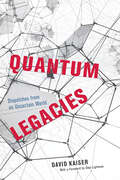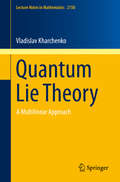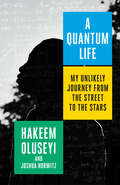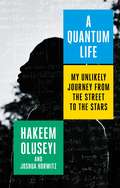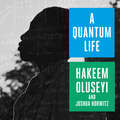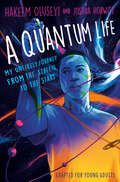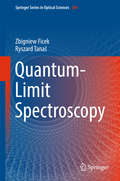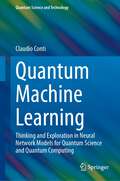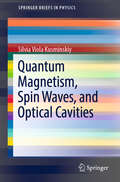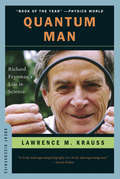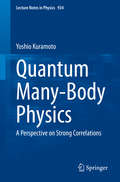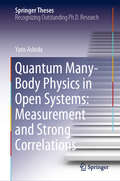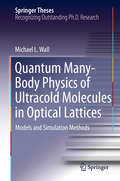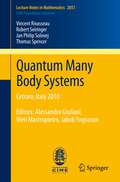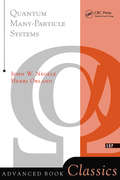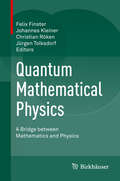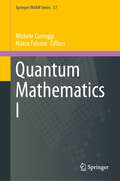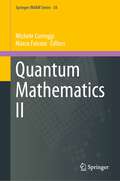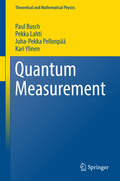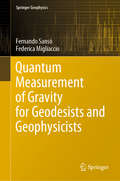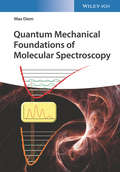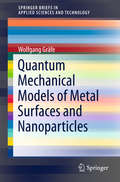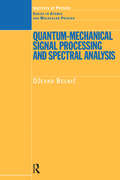- Table View
- List View
Quantum Legacies: Dispatches from an Uncertain World
by David KaiserThe ideas at the root of quantum theory remain stubbornly, famously bizarre: a solid world reduced to puffs of probability; particles that tunnel through walls; cats suspended in zombielike states, neither alive nor dead; and twinned particles that share entangled fates. For more than a century, physicists have grappled with these conceptual uncertainties while enmeshed in the larger uncertainties of the social and political worlds around them, a time pocked by the rise of fascism, cataclysmic world wars, and a new nuclear age. In Quantum Legacies, David Kaiser introduces readers to iconic episodes in physicists’ still-unfolding quest to understand space, time, and matter at their most fundamental. In a series of vibrant essays, Kaiser takes us inside moments of discovery and debate among the great minds of the era—Albert Einstein, Erwin Schrödinger, Stephen Hawking, and many more who have indelibly shaped our understanding of nature—as they have tried to make sense of a messy world. Ranging across space and time, the episodes span the heady 1920s, the dark days of the 1930s, the turbulence of the Cold War, and the peculiar political realities that followed. In those eras as in our own, researchers’ ambition has often been to transcend the vagaries of here and now, to contribute lasting insights into how the world works that might reach beyond a given researcher’s limited view. In Quantum Legacies, Kaiser unveils the difficult and unsteady work required to forge some shared understanding between individuals and across generations, and in doing so, he illuminates the deep ties between scientific exploration and the human condition.
Quantum Lie Theory
by Vladislav KharchenkoThis is an introduction to the mathematics behind the phrase "quantum Lie algebra". The numerous attempts over the last 15-20 years to define a quantum Lie algebra as an elegant algebraic object with a binary "quantum" Lie bracket have not been widely accepted. In this book, an alternative approach is developed that includes multivariable operations. Among the problems discussed are the following: a PBW-type theorem; quantum deformations of Kac--Moody algebras; generic and symmetric quantum Lie operations; the Nichols algebras; the Gurevich--Manin Lie algebras; and Shestakov--Umirbaev operations for the Lie theory of nonassociative products. Opening with an introduction for beginners and continuing as a textbook for graduate students in physics and mathematics, the book can also be used as a reference by more advanced readers. With the exception of the introductory chapter, the content of this monograph has not previously appeared in book form.
A Quantum Life: My Unlikely Journey from the Street to the Stars
by Hakeem Oluseyi Joshua HorwitzIn this inspiring coming-of-age memoir, a world-renowned astrophysicist emerges from an impoverished childhood and crime-filled adolescence to ascend through the top ranks of research physics. &“You&’ll encounter one extraordinary turn of events after another, as the extraordinary chess player, puzzle solver, and occasional grifter works his way from grinding poverty and deep despair to worldwide acclaim as a physicist.&”—Bill Nye, CEO of The Planetary Society Navigating poverty, violence, and instability, a young James Plummer had two guiding stars—a genius IQ and a love of science. But a bookish nerd is a soft target, and James faced years of bullying and abuse. As he struggled to survive his childhood in some of the country&’s toughest urban neighborhoods in New Orleans, Houston, and LA, and later in the equally poor backwoods of Mississippi, he adopted the persona of &“gangsta nerd&”—dealing weed in juke joints while winning state science fairs with computer programs that model Einstein&’s theory of relativity. Once admitted to the elite physics PhD program at Stanford University, James found himself pulled between the promise of a bright future and a dangerous crack cocaine habit he developed in college. With the encouragement of his mentor and the sole Black professor in the physics department, James confronted his personal demons as well as the entrenched racism and classism of the scientific establishment. When he finally seized his dream of a life in astrophysics, he adopted a new name, Hakeem Muata Oluseyi, to honor his African ancestors. Alternately heartbreaking and hopeful, A Quantum Life narrates one man&’s remarkable quest across an ever-expanding universe filled with entanglement and choice.
A Quantum Life: My Unlikely Journey from the Street to the Stars
by Hakeem Oluseyi Joshua HorwitzIn this inspiring coming-of-age memoir, a world-renowned astrophysicist emerges from an impoverished childhood and crime-filled adolescence to ascend through the top ranks of research physics.Navigating poverty, violence, and instability, a young James Plummer had two guiding stars-a genius IQ and a love of science. But a bookish nerd was a soft target in his community, where James faced years of bullying and abuse. As he struggled to survive his childhood in some of the country's toughest urban neighborhoods in New Orleans, Houston, and LA, and later in the equally poor backwoods of Mississippi, he adopted the persona of "gangsta nerd"-dealing weed in juke joints while winning state science fairs with computer programs that model Einstein's theory of relativity. Once admitted to the elite physics PhD program at Stanford University, James found himself pulled between the promise of a bright future and a dangerous crack cocaine habit he developed in college. With the encouragement of his mentor and the sole Black professor in the physics department, James confronted his personal demons as well as the entrenched racism and classism of the scientific establishment. When he finally seized his dream of a life in astrophysics, he adopted a new name, Hakeem Muata Oluseyi, to honor his African ancestors.Alternately heartbreaking and hopeful, A QUANTUM LIFE narrates one man's remarkable quest across an ever-expanding universe filled with entanglement and choice.
A Quantum Life: My Unlikely Journey from the Street to the Stars
by Hakeem Oluseyi Joshua HorwitzIn this inspiring coming-of-age memoir, a world-renowned astrophysicist emerges from an impoverished childhood and crime-filled adolescence to ascend through the top ranks of research physics.Navigating poverty, violence, and instability, a young James Plummer had two guiding stars-a genius IQ and a love of science. But a bookish nerd was a soft target in his community, where James faced years of bullying and abuse. As he struggled to survive his childhood in some of the country's toughest urban neighborhoods in New Orleans, Houston, and LA, and later in the equally poor backwoods of Mississippi, he adopted the persona of "gangsta nerd"-dealing weed in juke joints while winning state science fairs with computer programs that model Einstein's theory of relativity. Once admitted to the elite physics PhD program at Stanford University, James found himself pulled between the promise of a bright future and a dangerous crack cocaine habit he developed in college. With the encouragement of his mentor and the sole Black professor in the physics department, James confronted his personal demons as well as the entrenched racism and classism of the scientific establishment. When he finally seized his dream of a life in astrophysics, he adopted a new name, Hakeem Muata Oluseyi, to honor his African ancestors.Alternately heartbreaking and hopeful, A QUANTUM LIFE narrates one man's remarkable quest across an ever-expanding universe filled with entanglement and choice.
A Quantum Life (Adapted for Young Adults): My Unlikely Journey from the Street to the Stars
by Hakeem Oluseyi Joshua HorwitzA NASA astrophysicist narrates his improbable journey from an impoverished childhood and an adolescence mired in drugs and crime to the nation's top physics PhD program at Stanford in this inspiring coming-of-age memoir.Born into extreme poverty and emotional deprivation, James Edward Plummer was blessed with a genius I.Q. and a love of science. But in his community, a young bookworm quickly becomes a target for violence and abuse. As he struggles to survive his childhood in some of the toughest cities in the country, and his teenage years in the equally poor backwoods of Mississippi, James adopts the hybrid persona of a "gangsta nerd"--dealing weed in juke joints while winning state science fairs with computer programs that untangle the mysteries of Einstein's relativity theory.When his prodigious intellect gains him admission to the elite Physics PhD program at Stanford University, James finds himself torn between his love of science and a dangerous crack cocaine habit he developed in college. With the encouragement of his mentor Art Walker, the lone Black faculty member in the physics department, James finally seizes his dream of a life in science and becomes his true adult self, changing his name to Hakeem Muata Oluseyi in honor--and celebration--of his African heritage. In the tradition of The Autobiography of Malcolm X and The Other Wes Moore, A Quantum Life is an uplifting journey to the stars fueled by hope, hustle, and a hungry mind. As he charts his development as a young scientist, Oluseyi also plumbs the mysteries of the universe where potential personal outcomes are as infinite as the stars in the sky.
Quantum-Limit Spectroscopy
by Zbigniew Ficek Ryszard TanaśThis book covers the main ideas, methods, recent developments and applications of quantum-limit optical spectroscopy to quantum information, resolution spectroscopy, measurements beyond quantum limits, measurement of decoherence and entanglement. Quantum-limit spectroscopy lies at the frontier of current experimental and theoretical techniques, and is one of the areas of atomic spectroscopy where the quantization of the field is essential to predict and interpret the existing experimental results. Currently, there is an increasing interest in quantum and precision spectroscopy both theoretically and experimentally, due to a significant progress in trapping and cooling of single atoms and ions. This progress allows to explore in the most intimate detail the ways in which light interacts with atoms and to measure spectral properties and quantum effects with a large precision. Moreover, it allows to perform subtle tests of quantum mechanics on the single atom and single photon scale which were hardly even imaginable as ``thought experiments'' a few years ago.
Quantum Machine Learning: Thinking and Exploration in Neural Network Models for Quantum Science and Quantum Computing (Quantum Science and Technology)
by Claudio ContiThis book presents a new way of thinking about quantum mechanics and machine learning by merging the two. Quantum mechanics and machine learning may seem theoretically disparate, but their link becomes clear through the density matrix operator which can be readily approximated by neural network models, permitting a formulation of quantum physics in which physical observables can be computed via neural networks. As well as demonstrating the natural affinity of quantum physics and machine learning, this viewpoint opens rich possibilities in terms of computation, efficient hardware, and scalability. One can also obtain trainable models to optimize applications and fine-tune theories, such as approximation of the ground state in many body systems, and boosting quantum circuits’ performance. The book begins with the introduction of programming tools and basic concepts of machine learning, with necessary background material from quantum mechanics and quantum information also provided. This enables the basic building blocks, neural network models for vacuum states, to be introduced. The highlights that follow include: non-classical state representations, with squeezers and beam splitters used to implement the primary layers for quantum computing; boson sampling with neural network models; an overview of available quantum computing platforms, their models, and their programming; and neural network models as a variational ansatz for many-body Hamiltonian ground states with applications to Ising machines and solitons. The book emphasizes coding, with many open source examples in Python and TensorFlow, while MATLAB and Mathematica routines clarify and validate proofs. This book is essential reading for graduate students and researchers who want to develop both the requisite physics and coding knowledge to understand the rich interplay of quantum mechanics and machine learning.
Quantum Magnetism, Spin Waves, and Optical Cavities (SpringerBriefs in Physics)
by Silvia Viola KusminskiyThis primer thoroughly covers the fundamentals needed to understand the interaction of light with magnetically ordered matter and it focuses on "cavity optomagnonics" which is a topic undergoing intense study in current research.The book is unique in combining elements of electromagnetism, quantum magnetism, and quantum optics and it is intended for advanced undergraduate or graduate students.
Quantum Man: Richard Feynman's Life In Science (Great Discoveries #0)
by Lawrence M. Krauss"A worthy addition to the Feynman shelf and a welcome follow-up to the standard-bearer, James Gleick's Genius." --Kirkus Reviews Perhaps the greatest physicist of the second half of the twentieth century, Richard Feynman changed the way we think about quantum mechanics, the most perplexing of all physical theories. Here Lawrence M. Krauss, himself a theoretical physicist and a best-selling author, offers a unique scientific biography: a rollicking narrative coupled with clear and novel expositions of science at the limits. From the death of Feynman's childhood sweetheart during the Manhattan Project to his reluctant rise as a scientific icon, we see Feynman's life through his science, providing a new understanding of the legacy of a man who has fascinated millions.
Quantum Many-Body Physics: A Perspective on Strong Correlations (Lecture Notes in Physics #934)
by Yoshio KuramotoThis book offers a compact tutorial on basic concepts and tools in quantum many-body physics, and focuses on the correlation effects produced by mutual interactions.The content is divided into three parts, the first of which introduces readers to perturbation theory. It begins with the simplest examples—hydrogen and oxygen molecules—based on their effective Hamiltonians, and looks into basic properties of electrons in solids from the perspective of localized and itinerant limits. Readers will also learn about basic theoretical methods such as the linear response theory and Green functions. The second part focuses on mean-field theory for itinerant electrons, e.g. the Fermi liquid theory and superconductivity. Coulomb repulsion among electrons is addressed in the context of high-Tc superconductivity in cuprates and iron pnictides. A recent discovery concerning hydride superconductors is also briefly reviewed. In turn, the third part highlights quantum fluctuation effects beyond the mean-field picture. Discussing the dramatic renormalization effect in the Kondo physics, it provides a clear understanding of nonperturbative interaction effects. Further it introduces readers to fractionally charged quasi-particles in one and two dimensions. The last chapter addresses the dynamical mean field theory (DMFT).The book is based on the author’s long years of experience as a lecturer and researcher. It also includes reviews of recent focus topics in condensed matter physics, enabling readers to not only grasp conventional condensed matter theories but also to catch up on the latest developments in the field.
Quantum Many-Body Physics in Open Systems: Measurement and Strong Correlations (Springer Theses)
by Yuto AshidaThis book studies the fundamental aspects of many-body physics in quantum systems open to an external world. Recent remarkable developments in the observation and manipulation of quantum matter at the single-quantum level point to a new research area of open many-body systems, where interactions with an external observer and the environment play a major role. The first part of the book elucidates the influence of measurement backaction from an external observer, revealing new types of quantum critical phenomena and out-of-equilibrium dynamics beyond the conventional paradigm of closed systems. In turn, the second part develops a powerful theoretical approach to study the in- and out-of-equilibrium physics of an open quantum system strongly correlated with an external environment, where the entanglement between the system and the environment plays an essential role. The results obtained here offer essential theoretical results for understanding the many-body physics of quantum systems open to an external world, and can be applied to experimental systems in atomic, molecular and optical physics, quantum information science and condensed matter physics.
Quantum Many-Body Physics of Ultracold Molecules in Optical Lattices
by Michael L. WallThis thesis investigates ultracold molecules as a resource for novel quantum many-body physics, in particular by utilizing their rich internal structure and strong, long-range dipole-dipole interactions. In addition, numerical methods based on matrix product states are analyzed in detail, and general algorithms for investigating the static and dynamic properties of essentially arbitrary one-dimensional quantum many-body systems are put forth. Finally, this thesis covers open-source implementations of matrix product state algorithms, as well as educational material designed to aid in the use of understanding such methods.
Quantum Many Body Systems
by Vieri Mastropietro Jakob Yngvason Vincent Rivasseau Jan Philip Solovej Thomas Spencer Alessandro Giuliani Robert SeiringerThe book is based on the lectures given at the CIME school "Quantum many body systems" held in the summer of 2010. It provides a tutorial introduction to recent advances in the mathematics of interacting systems, written by four leading experts in the field: V. Rivasseau illustrates the applications of constructive Quantum Field Theory to 2D interacting electrons and their relation to quantum gravity; R. Seiringer describes a proof of Bose-Einstein condensation in the Gross-Pitaevski limit and explains the effects of rotating traps and the emergence of lattices of quantized vortices; J.-P. Solovej gives an introduction to the theory of quantum Coulomb systems and to the functional analytic methods used to prove their thermodynamic stability; finally, T. Spencer explains the supersymmetric approach to Anderson localization and its relation to the theory of random matrices. All the lectures are characterized by their mathematical rigor combined with physical insights.
Quantum Many-particle Systems (Advanced Books Classics Ser.)
by John W. NegeleThis book explains the fundamental concepts and theoretical techniques used to understand the properties of quantum systems having large numbers of degrees of freedom. A number of complimentary approaches are developed, including perturbation theory; nonperturbative approximations based on functional integrals; general arguments based on order parameters, symmetry, and Fermi liquid theory; and stochastic methods.
Quantum Mathematical Physics
by Felix Finster Johannes Kleiner Christian Röken Jürgen TolksdorfQuantum physics has been highly successful for more than 90 years. Nevertheless, a rigorous construction of interacting quantum field theory is still missing. Moreover, it is still unclear how to combine quantum physics and general relativity in a unified physical theory. Attacking these challenging problems of contemporary physics requires highly advanced mathematical methods as well as radically new physical concepts. This book presents different physical ideas and mathematical approaches in this direction. It contains a carefully selected cross-section of lectures which took place in autumn 2014 at the sixth conference ``Quantum Mathematical Physics - A Bridge between Mathematics and Physics'' in Regensburg, Germany. In the tradition of the other proceedings covering this series of conferences, a special feature of this book is the exposition of a wide variety of approaches, with the intention to facilitate a comparison. The book is mainly addressed to mathematicians and physicists who are interested in fundamental questions of mathematical physics. It allows the reader to obtain a broad and up-to-date overview of a fascinating active research area.
Quantum Mathematics I (Springer INdAM Series #57)
by Michele Correggi Marco FalconiThis book is the first volume that provides an unique overview of the most recent and relevant contributions in the field of mathematical physics with a focus on the mathematical features of quantum mechanics. It is a collection of review papers together with brand new works related to the activities of the INdAM Intensive Period "INdAM Quantum Meetings (IQM22)", which took place at the Politecnico di Milano in Spring 2022 at Politecnico di Milano. The range of topics covered by the book is wide, going ranging from many-body quantum mechanics to semiclassical analysis, quantum field theory, Schrödinger and Dirac operators and open quantum systems
Quantum Mathematics II (Springer INdAM Series #58)
by Michele Correggi Marco FalconiThis book is the second volume that provides an unique overview of the most recent and relevant contributions in the field of mathematical physics with a focus on the mathematical features of quantum mechanics. It is a collection of review papers together with brand new works related to the activities of the INdAM Intensive Period "INdAM Quantum Meetings (IQM22)", which took place at the Politecnico di Milano in Spring 2022 at Politecnico di Milano. The range of topics covered by the book is wide, going ranging from many-body quantum mechanics to quantum field theory and open quantum systems.
Quantum Measurement
by Kari Ylinen Juha-Pekka Pellonpää Pekka Lahti Paul BuschThis is a book about the Hilbert space formulation of quantum mechanics and its measurement theory. It contains a synopsis of what became of the Mathematical Foundations of Quantum Mechanics since von Neumann's classic treatise with this title. Fundamental non-classical features of quantum mechanics--indeterminacy and incompatibility of observables, unavoidable measurement disturbance, entanglement, nonlocality--are explicated and analysed using the tools of operational quantum theory. The book is divided into four parts: 1. Mathematics provides a systematic exposition of the Hilbert space and operator theoretic tools and relevant measure and integration theory leading to the Naimark and Stinespring dilation theorems; 2. Elements develops the basic concepts of quantum mechanics and measurement theory with a focus on the notion of approximate joint measurability; 3. Realisations offers in-depth studies of the fundamental observables of quantum mechanics and some of their measurement implementations; and 4. Foundations discusses a selection of foundational topics (quantum-classical contrast, Bell nonlocality, measurement limitations, measurement problem, operational axioms) from a measurement theoretic perspective. The book is addressed to physicists, mathematicians and philosophers of physics with an interest in the mathematical and conceptual foundations of quantum physics, specifically from the perspective of measurement theory.
Quantum Measurement and Control
by Howard M. Wiseman Gerard J. MilburnThe control of individual quantum systems promises a new technology for the 21st century - quantum technology. This book is the first comprehensive treatment of modern quantum measurement and measurement-based quantum control, which are vital elements for realizing quantum technology. Readers are introduced to key experiments and technologies through dozens of recent experiments in cavity QED, quantum optics, mesoscopic electronics, and trapped particles several of which are analyzed in detail. Nearly 300 exercises help build understanding, and prepare readers for research in these exciting areas. This important book will interest graduate students and researchers in quantum information, quantum metrology, quantum control and related fields. Novel topics covered include adaptive measurement; realistic detector models; mesoscopic current detection; Markovian, state-based and optimal feedback; and applications to quantum information processing.
Quantum Measurement of Gravity for Geodesists and Geophysicists (Springer Geophysics)
by Fernando Sansò Federica MigliaccioDuring the last thirty years a great advancement in low energy physics, particularly interactions of atoms with the electromagnetic field, has been achieved and the development of electronics and laser techniques has allowed to implement a fine manipulation of atoms with photons. A wealth of important applications has sprung out from the ability of manipulating large samples of cold atoms. Among them, the improvement of atomic clocks and the creation of atomic gyroscopes and of atomic gravity meters, which is obviously of great interest for geodesists and geophysicists, particularly for potential applications in satellite geodesy.This book explains the fundamental concepts necessary to understand atom manipulation by photons, including the principles of quantum mechanics. It is conceived as a road that leads the reader from classical physics (mechanics and electromagnetism, considered as a common scientific background of geodesists and geophysicists), to the basics of quantum mechanics in order to understand the dynamics of atoms falling in the gravity field, while interacting with suitably resonant laser beams. There are different types of measurements of gravity based on the manipulation of ultra-cold atoms; the book presents the principles of the instruments based on stimulated Raman transition, which can be easily worked out analytically. However, the concepts explained in the text can provide a good starting point to understand also the applications based on the so-called Block oscillations or on the Bose–Einstein condensation.
Quantum Measurement Theory and its Applications
by Kurt JacobsRecent experimental advances in the control of quantum superconducting circuits, nano-mechanical resonators and photonic crystals has meant that quantum measurement theory is now an indispensable part of the modelling and design of experimental technologies. This book, aimed at graduate students and researchers in physics, gives a thorough introduction to the basic theory of quantum measurement and many of its important modern applications. Measurement and control is explicitly treated in superconducting circuits and optical and opto-mechanical systems, and methods for deriving the Hamiltonians of superconducting circuits are introduced in detail. Further applications covered include feedback control, metrology, open systems and thermal environments, Maxwell's demon, and the quantum-to-classical transition.
Quantum Mechanical Foundations of Molecular Spectroscopy
by Max DiemA concise textbook bridging quantum theory and spectroscopy! Designed as a practical text, Quantum Mechanical Foundations of Molecular Spectroscopy covers the quantum mechanical fundamentals of molecular spectroscopy from the view of a professional spectroscopist, rather than a theoretician. Written by a noted expert on the topic, the book puts the emphasis on the relationship between spectroscopy and quantum mechanics, and provides the background information and derivations of the subjects needed to understand spectroscopy including: stationary energy states, transitions between these states, selection rules, and symmetry. The phenomenal growth of all forms of spectroscopy over the past eight decades has contributed enormously to our understanding of molecular structure and properties. Today spectroscopy covers a broad field including the modern magnetic resonance techniques, non-linear, laser and fiber-based spectroscopy, surface and surface-enhanced spectroscopy, pico- and femtosecond time resolved spectroscopy, and many more. This up-to-date resource discusses several forms of spectroscopy that are used in many fields of science, such as fluorescence, surface spectroscopies, linear and non-linear Raman spectroscopy and spin spectroscopy. This important text: Contains the physics and mathematics needed to understand spectroscopy Explores spectroscopic methods the are widely used in chemistry, biophysics, biology, and materials science Offers a text written by an experienced lecturer and practitioner of spectroscopic methods Includes detailed explanations and worked examples Written for chemistry, biochemistry, material sciences, and physics students, Quantum Mechanical Foundations of Molecular Spectroscopy provides an accessible text for understanding molecular spectroscopy.
Quantum Mechanical Models of Metal Surfaces and Nanoparticles
by Wolfgang GräfeThis book proposes two simple quantum mechanical models for the analytical description of metal surfaces and nanoparticles. It gives an ostensive picture of the forces acting in a metal surface and deduces analytical formulae for the description of their physical properties. This book explains the relation between near-surface stress and familiar surface parameters. The concept of the separation of the three-dimensional body into three one-dimensional subsystems was applied. The content is of interest to all those working in the field of surface physics.
Quantum-Mechanical Signal Processing and Spectral Analysis (Series in Atomic Molecular Physics)
by Dzevad BelkicQuantum-Mechanical Signal Processing and Spectral Analysis describes the novel application of quantum mechanical methods to signal processing across a range of interdisciplinary research fields. Conventionally, signal processing is viewed as an engineering discipline with its own specific scope, methods, concerns and priorities, not usually encompassing quantum mechanics. However, the dynamics of systems that generate time signals can be successfully described by the general principles and methods of quantum physics, especially within the Schroedinger framework. Most time signals that are measured experimentally are mathematically equivalent to quantum-mechanical auto-correlation functions built from the evolution operator and wavefunctions. This fact allows us to apply the rich conceptual strategies and mathematical apparatus of quantum mechanics to signal processing. Among the leading quantum-mechanical signal processing methods, this book emphasizes the role of Pade approximant and the Lanczos algorithm, highlighting the major benefits of their combination. These two methods are carefully incorporated within a unified framework of scattering and spectroscopy, developing an algorithmic power that can be exported to other disciplines. The novelty of the author's approach to key signal processing problems, the harmonic inversion and the moment problem, is in establishing the Pade approximant and Lanczos algorithm as entirely algerbraic spectral estimators. This is of paramount theoretical and practical importance, as now spectral analysis can be carried out from closed analytical expressions. This overrides the notorious mathematical ill-conditioning problems with round-off errors that plague inverse reconstructions in those fields that rely upon signal processing. Quantum-Mechanical Signal Processing and Spectral Analysis will be an invaluable resource for researchers involved in signal processing across a wide range of disciplines.
